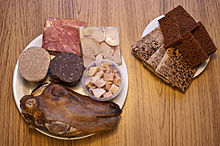Thorra blot
Þorrablót or Thorra-blot ( Old Norse Þorra-blót ) is an Icelandic mid-winter festival that has its roots in a North Germanic festival of sacrifice and was revived in the 19th century.
North Germanic Festival of Sacrifice
The North Germanic Festival of Sacrifice was celebrated in the last winter month of Þorri . It has a close cultic-ritual relationship to the other periodically celebrated sacrificial festivals during the year. At least this applies to the north-western Germanic peoples of Norway and Iceland during the Viking Age , since the Germanic religion as a whole, including the North Germanic religion , was subject to locally different stratifications in ritual and cult and was shaped by this decentralization.
According to the Orkneyinga saga , Þorri ("frost") was an early Finnish king, the son of Snær ("snow"). Otherwise Þorri is also referred to as a frost giant. The writing Hversu Noregr byggðist from the 12th century, which has been handed down in Flateyjarbók , states that the Kven people made an annual sacrifice to Þorri in midwinter. The god Thor (Þórr) is associated with Þorri. Blót is a general name for festivals in honor of a deity in North Germanic paganism.
Today's festival
The tradition of Þorrablót was revived in the 19th century and is now part of Icelandic folk culture. The revival of the festival is closely related to the Icelandic struggle for independence and the rise of nationalism in Iceland . The pagan times apply in the history of Iceland as a golden age . The first surviving modern Þorrablót was started in 1873 by Icelandic students in Copenhagen .
In its modern form, Þorrablót is celebrated as a dinner where participants give speeches and recite poetry. The festival received widespread attention in the 1960s when the Naustið restaurant in Reykjavík offered a dinner called Þorramatur , which consisted of traditional Icelandic dishes served on a wooden trough. The idea was well received by the population and today Þorramatur is an integral part of Þorrablót.
The Þorrablót can be celebrated informally with family and friends, but also as a large organized event with a stage show and dance after dinner. The month of Þorri in the Old Icelandic calendar begins between January 19 and 26 (always on a Friday) and ends between February 17 and 23 (always on a Saturday).
See also
literature
- Franz Joseph Mone: The religions of the Finnish, Slavic and Scandinavian peoples . In: History of Paganism in Northern Europe (= symbolism and mythology of the ancient peoples, especially the Greeks . Volume 5 ). Part 1. Leske, Leipzig / Darmstadt 1822, p. 273 ( books.google.de ).
- Walter Baetke: The religion of the Teutons in source certificates. 3rd, combined and enlarged edition. Diesterweg, Frankfurt a. M. 1944, OCLC 252088912 (first edition: 1937).
- Walter Baetke: Dictionary of Old Norse prose literature (= session reports of the Saxon Academy of Sciences in Leipzig [Philological-Historical Class] . Volume 111 , Issue 1: A – L , Issue 2: M – Ø ). 8th, unchanged edition. Akademie-Verlag, Berlin 2008, ISBN 978-3-05-004897-0 (first published in 1965 and 1968).
- Jan de Vries: Old Germanic history of religion (= outline of Germanic philology . Volume 12 /1 and 12/2). 3rd, unchanged edition. tape 2 : The gods - ideas about the cosmos - the fall of paganism . de Gruyter, Berlin 1970, ISBN 3-11-085519-4 (Fotomech. Reprint of the 2nd completely revised edition 1957).
